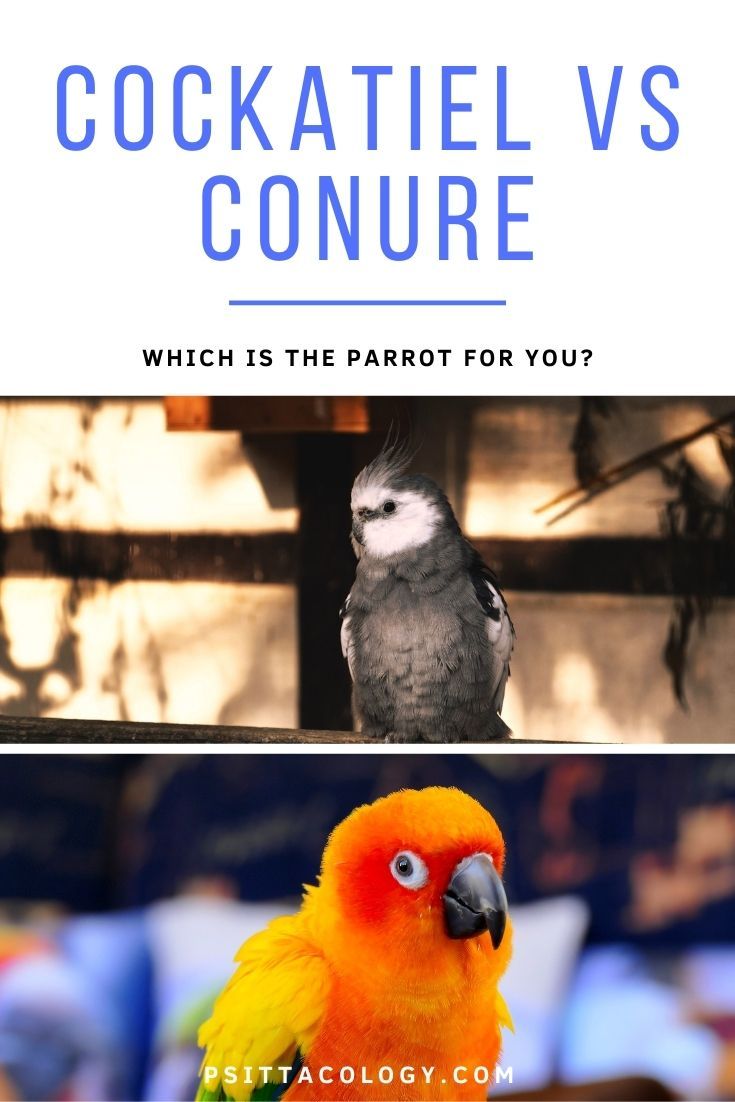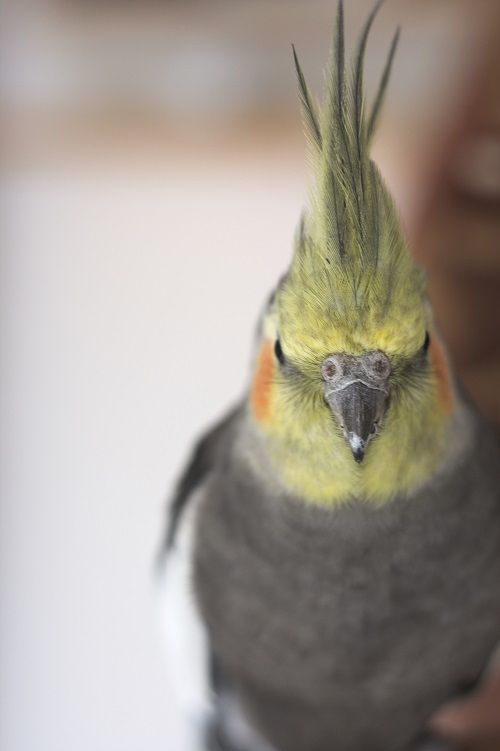If you’re trying to choose the right parrot species to add to your family, you may end up stuck between a cockatiel or a conure. Understandable: both are popular parrots that can make wonderful pets.
If you’re not sure which to go for, keep reading! We’ll discuss cockatiel vs conure differences, similarities and who which species is better for.
This post contains affiliate links. If you make a purchase, a small percentage will go directly to Psittacology at no additional cost to you. Thank you for supporting Psittacology!
Cockatiel vs conure: Differences
If you’re having trouble choosing between a cockatiel and one of the many types of conures, that’s not surprising. Although they’re both very popular, they’re actually not that similar at all in many respects. Luckily, this makes it easier to choose between the two.
Let’s have a look at some of the main differences between cockatiel vs conure.
The species
- Taxonomy. Cockatiels are a single parrot species, Nymphicus hollandicus, although they occur in different colors. “Conure” is a non-scientific term used to describe various parrot genera: there are many types of conures. Green cheek conures and sun conures are the most popular.
- Size. There are some conure species that are quite similar in size to cockatiels. However, there are also many that are considerably smaller or much larger. All parrots need a large cage, but the bigger conure varieties even more so.
- Habitat. Wild cockatiels are naturally found throughout Australia, mostly the arid zones. Conures are present throughout Central and South America, where they inhabit all sorts of habitats.
- Lifespan. Both cockatiels and some conure species can live for up to 30 years in exceptional cases, although up to 20 is more common. The most popular conure species, the green cheek conure, is known for living a bit shorter, usually reaching a maximum of 15 years.

Personality
- Activity level. Cockatiels are known as one of the most chilled out parrot species available as pets. This is not to say they’re always calm, they’re still parrots, but they’re not all over the place. Conures, on the other hand tend to be active, boisterous, curious and clownish.
- Noise levels. In line with the previous, although cockatiels can be quite loud, they’re still on the list of quietest parrots. Don’t expect the same from conures, especially the popular genus Aratinga, which includes sun conures. They’re very vocal.
- Talking abilities. Although neither species is known for its huge vocabulary, cockatiels are still quite good at imitating whistles. Conures can learn a few tunes, but their abilities seem a bit more limited.
- Affection levels. Although both species can love to cuddle, parrot enthusiasts report that cockatiels tend to be a bit more demanding in terms of neck scratches. Conures are more prone to nippiness when they’re excited, meaning you have to train them well to avoid bites.
- Trainability. Although both species are very intelligent and easily learn tricks, it tends to be the conures that are more trainable. They just seem to be more willing to put in the work!
Other
- Allergies. Cockatiels are members of the cockatoo family, meaning they sport a layer of down under their normal feathers. This down layer is very dusty and can cause cockatiels to trigger dust allergies more strongly than other parrots.

Who is a conure better for?
This comes down mostly to the activity level you’re looking for in a bird. You’ll love a conure if you’re looking for a cheerful buddy that can make you laugh with its antics and if you have the patience to train your bird to prevent possible behavioral issues like nipping. You’ll have to be able to handle a bit of noise, as many species can get pretty loud.
Like cockatiels, conures can be very cuddly birds, but they’re also curious and bold. You’ll enjoy training time with your conure, introducing it to fun new toys and sharing the hustle and bustle of a busy household with it.
Who is a cockatiel better for?
As mentioned, as far as parrots go, cockatiels are very relaxed. They still love playing and yes, they can be loud, but usually much less so than most other parrot species. Although they can definitely be cranky birds, they’re not overly prone to biting or other behavioral issues.
A tame cockatiel will probably prefer hanging out for snuggles over training time (although things can get intense if you’re not willing to share your popcorn!). They’re sweet, cheerful and clumsy; the males especially can be very funny when they strut their stuff, whistle songs and show off.

Frequently asked questions
They might, but conures tend to be a bit too hyperactive. They may be able to play together outside of their cages under supervision, but they should never be kept in the same enclosure.
Well, they might try. However, since they belong to different genera, they will not be able to produce offspring together.
Conclusion
Even if this article has given you an idea of which parrot better suits you, it’s still a good idea to research more before making a decision. After all, getting a parrot is a commitment for decades to come!
If you have family or friends with a conure or cockatiel, try asking if you can come and visit to get to know their parrot. You can also try local pet shops or parrot rescues to get to know these birds better.
If you have any more questions about cockatiel vs conure or if you want to share your experiences with either of these delightful parrots, don’t hesitate to leave a comment below.
Still not sure which parrot species to go for? Check out the other parrot comparison guides to help narrow it down.

Hi i have a cerelestrial parelette canaure 4.5 centre mtrs ive hadit just over a yr love him to bits i dont let him out cage in case he flys behind my tv its to heavy to move i live on my own is that ok to not let him out gets quite chrppy xx
Hi! Unfortunately, your parrot does need daily out of cage time. It’s important to parrot-proof a space for him (make it 100% safe) to fly around in and explore. Hope you’ll consider doing so! Enjoy your bird 🙂